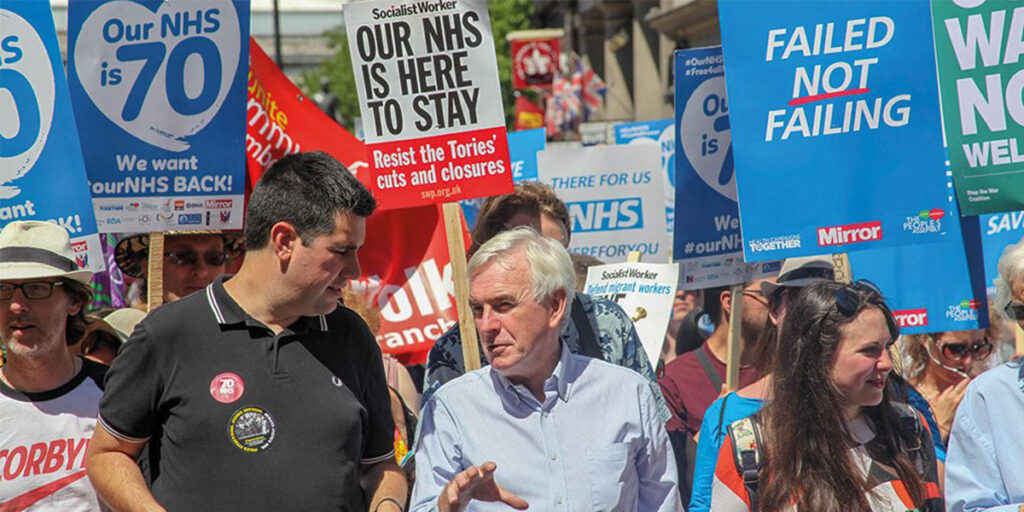No. It’s true that the NHS is well-regarded when it comes to affordability and access for all. One US think tank, the Commonwealth Fund, which publishes a survey comparing 11 rich-country health systems every three years, rates the NHS top on those criteria – as well as strong on safety and reasonably efficient. The trouble is that, according to its latest report last year, “the UK stands out as a top performer in most categories except for healthcare outcomes, where it ranks with the US near the bottom”. In other words, as The Guardian wrote when reporting on the Commonwealth Fund’s previous study, “the only serious black mark against the NHS was its poor record on keeping people alive”.
Have other analyses found the same?
Yes. A recent report by four British think tanks (How Good is the NHS?) found that the NHS provides reasonable value and efficiency compared with 18 similar rich countries, but that “for the most important illnesses indirectly causing death, it is a consistently below-average performer”. It is odd that this crucial fact gets so little attention, say the report’s authors – and that media and politicians remain so focused on waiting times, where the UK’s performance is roughly average. In particular, it is poor at treating killer conditions such as cancer, lung disease, heart attacks, and strokes, and is below average on “amenable mortality” – that is, the rate at which people die as a result of conditions where medical intervention should be able to save their lives.
What’s going wrong?
One major reason could be that the UK has only 2.8 doctors per 1,000 population, compared with a rich-country average of 3.6. It also has an exceptionally low number of hospital beds: 2.6 per 1,000 population, compared with an unweighted average of 4.5 across the other countries. Babies born in the UK have higher rates of perinatal and neonatal mortality than the average. One bright spot is that Britain has low suicide rates, suggesting mental healthcare is better than many belief. And the NHS is good at treating kidney disease and diabetes.
Does Britain spend the same as its peers?
Yes. The UK spent around 9.7% of GDP on healthcare in 2016 (compared with an average of 10.2% for the other 18 nations, and up from around 6% at the turn of the century). That’s a bit less than France and Germany (11%; 11.3%) , but more than Ireland (7.8%) and several southern European countries such as Spain (9%).
America is the extreme outlier: it spends far more on healthcare (17.2%) than other countries and gets a very poor return on its investment. However, the boost to funding recently announced by the UK government (an extra £20bn a year by 2024 on top of the current annual spend of around £120bn) has been greeted with relief rather than joy by health workers. That’s because the average annual increase involved is just 3.4% in real terms, less than the long-run average of 3.7% since 1948.
What are the underlying issues?
Partly it’s several years of below-average funding increases: since 2009-2010 spending has grown by 1.4% a year at a time of population growth and surging demand. Partly, it’s the fact that the costs of medical technology are rising way ahead of overall inflation. For example, in the five years to 2016-17, the total bill for prescriptions from hospital pharmacies shot up by 70%. And partly, the issue is demographics. For most people, spending on healthcare is inevitably and overwhelmingly skewed towards the latter years of life. This makes the UK system of universal healthcare, free at the point of delivery and entirely funded from current tax receipts, a model that amounts to a transfer from the working-age population to retirees. That’s all fine, until longevity increases as birth rates decline.
Aren’t other countries aging too?
Yes, but their “social-insurance” model of funding – still universal, still free at the point of delivery – is far better suited to withstand the pressures. For example, in Switzerland, everyone has to have a health insurance policy in place, but those on lower incomes are subsidized by the state to buy one. Thus, in effect, the system is akin to a health tax which only the richer pay. Crucially, the risks are pooled across the population: you do not pay higher premiums if you are older and have a long track record of illness. Instead, under a population-wide compensation system, insurers who take on a larger-than-average share of the older and sicker are reimbursed by other insurers.
Who does the actual health provision?
There’s no nationalized, monopoly health service. Instead, there are two layers of competition aimed at driving efficiency, modernity, and convenience. First, insurers (which include institutions such as trade unions and professional bodies) compete to offer the best value policies. Second, doctors, diagnostic facilities, and hospitals also compete to provide services paid for by the insurers. The result, as in Germany and the Netherlands (which have similar systems), is better-funded healthcare that delivers shorter waiting times, better health outcomes, and fewer avoidable deaths.
Should the UK go down this road?
At present, it’s not a runner. A dedicated “health tax” is a possibility that looks more plausible. This would scarcely be a panacea: like all hypothecated taxes it risks providing a too-variable and thus high-risk revenue stream. But it would have the benefit of transparency and might help foster a broader debate by focusing minds on what the NHS actually costs each taxpayer. As things stand, the NHS is morphing into a state religion – one that needs more heretics and fewer acolytes.



